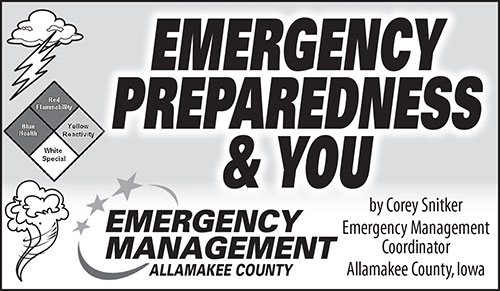You are here
Home ›Emergency Preparedness and You: What Does Emergency Management Do: Part 1

Hello, I hope everyone is enjoying the New Year. What a cold end to 2017 and start to 2018! But, hopefully by the time this article is printed, we enjoyed a warm Sunday and a warmer current week than the previous ones.
With my upcoming articles, I wanted to shift away from weather readiness and take some time to talk about emergency management itself and answer the question that I am often asked: what does Emergency Management do?
While this should be a simple answer; one answer is emergency management is the managerial function charged with creating the framework within which communities reduce vulnerability to hazards and cope with disasters; the actual answer is a little more complex, and after almost two years on the job come April 25, I am still learning what it means to be emergency management. However, a good place to start in providing an answer to this question, and which is the base for my understanding, is looking at why emergency management exists in Iowa and where its mission comes from.
This answer can be found in two documents: Iowa Code Chapter 29C, Emergency Management and Security and also in Iowa Administrative Code: Homeland Security and Emergency Management Department (605), Chapter 7, specifically for local emergency management.
Iowa Code Chapter 29C establishes the local emergency management organizations and specifically tasks the county board of supervisors, city councils and the sheriff in each county to establish a commission to carry out the provisions of this chapter. This commission consists of a member of the board of supervisors, the sheriff and the mayor from each city within the county. So, in Allamakee County, the commission is made up of eight members as we have six cities represented as well as a representative from the board of supervisors and the sheriff.
The commission then establishes an agency, which locally is the Allamakee County Emergency Management Agency, to carry out the daily operations and also hires a coordinator to lead the agency. This coordinator is then delegated the responsibilities to fulfill the commission's duties as described in the administrative rules.
The Emergency Management Coordinator is not a member of this commission, but an employee. Additionally, a couple of other key parts to the Iowa Code Chapter 29C are that it establishes the position of coordinator and also the funding options for the agency.
Therefore, every county in Iowa is directed to have an Emergency Management Agency, though counties are allowed to combine their commissions together. Within Iowa there are 93 coordinators as several smaller-population counties have combined to form one agency between them. The majority of coordinators are full-time positions, approximately 78, with normally just the coordinator employed within the agency, though some of the larger-population counties, i.e. Polk, Linn, Johnson and a few others, have small staffs within the agency, in addition to the coordinator.
Iowa Administrative Code 605 provides the detailed guidance, duties and responsibilities of the commission, agency and coordinator in Chapter 7. Some highlights from this chapter include the qualifications a coordinator is supposed to meet to be hired, the minimum training requirements a coordinator needs to complete within two years from being hired and the requirement to complete an additional 24 hours of state-approved emergency management training every year upon completing their initial training. Upon being hired, an Emergency Management Coordinator, within these first two years, must complete four sessions of Emergency Management Program Development at the state level and 17 online courses through FEMA.
Additionally, the chapter also establishes the duties and responsibilities of the commission, which include the following 11 areas of focus: administration and finance; hazard identification, risk assessment and capability assessment; resource management; planning; direction, control and coordination; damage assessment; communications and warning; operations and procedures; training; exercises; and public information and information. Within these 11 areas of focus are 48 specific tasks and these areas of focus and tasks are the minimum requirements the agency is to accomplish.
I will now close out this portion of the article, but will continue in the next one by highlighting some of these tasks and other aspects of emergency management and continue to answer the question of what emergency management does.
Thanks, and please continue to watch the weather, be prepared and be safe.

